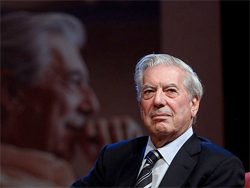The old man has always been a Romantic. It is easy to picture him there in the military boarding school in Lima, 1950. He describes it to us in four words; damp, gray, boring, unhappy. That was Mario Vargas Llosa 60 years before he won the Nobel Prize for literature.
In the face of the doldrums, Vargas Llosa turned to Victor Hugo. Who else is a sensitive young lad living in Peru going to turn to? I say this jokingly, but also, not. In a curious and enjoyable little book Vargas Llosa wrote about Hugo’s Les Misérables (The Temptation of the Impossible: Victor Hugo and “Les Misérables”), he describes being carried away by Hugo’s world of “extreme misfortune, love, courage, happiness, and vile deeds.”
But more than that, Vargas Llosa speaks about being caught in the horns of a dilemma. Vargas Llosa found solace in the amazing fictional worlds created by Victor Hugo. Escaping into the world of Jean Valjean gave Vargas Llosa the fortitude he needed to face the real world. But it also made the real world seem pale in comparison. Real reality couldn’t live up to the dreams of Victor Hugo. Hugo was, thus, helping Mario Vargas Llosa with the problems of the real world and taking away his faith in reality at the same time.
It’s remarkable that Vargas Llosa was aware of this dilemma from the very beginning. It would become an abiding theme in all his work. How could it not? It is a big dilemma, juicy, deep, intractable. It is the central and persistent Romantic theme, the pull and simultaneous insufficiency of reality, but Vargas Llosa has always made it specifically his own. You can read his novels according to that central problem, but you can read his failed run for the Peruvian presidency in 1990 along the lines of the same dilemma.
Among other tasks, Vargas Llosa took up the job of translating the problems of 19th-century European Romanticism into the realities of 20th-century Latin America. You could say it was pointless, anachronistic. But it worked. In Peru, and in many other Latin American countries as well, the Romantic yearning was thick in the air during most of this century just past. The extreme contrast between hopes and reality was there to be seen on every street corner, in a way that Hugo would have understood far more immediately than any of Vargas Llosa’s contemporaries in the U.S. or Western Europe. Vargas Llosa had to go backward one century in order to find a true contemporary. It meant, sometimes, an act of almost willful naïveté. “How many readers,” Vargas Llosa asks, “still believe that literature can revolutionize existence, subvert society, and win us eternal life.”
I’m not the one to make grand proclamations about “Latin American Literature.” But the attempt to believe those things, the tantalizing feeling that you can almost believe them, runs through the Latin American literature of which Vargas Llosa has been a primary figure like a pulsing vein. It certainly runs through Vargas Llosa’s literature. We can say that much, at least. Vargas Llosa knows that those dreams, those beliefs, don’t lead to anything definite. “It is difficult to know whether the falsehoods that our imagination conjures up help us to live or contribute to our misfortune by revealing the insuperable gap between reality and dreams, whether they dull our resolve or encourage us to act.” But no Romantic has ever figured that out, from Byron to Hugo to Mario Vargas Llosa. It is enough to tarry with that problem, to kick it around your own block in your own time, which is what Vargas Llosa has been doing, tempting himself with the impossible. • 12 October 2010




